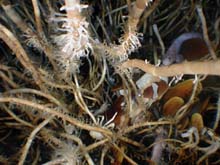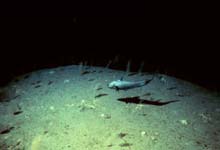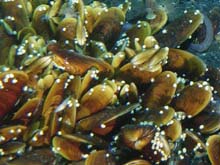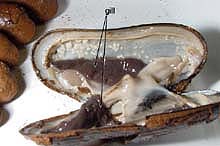Life on the abyssal sea floor near the Hudson Canyon off the coast of New Jersey. Click image for larger view.
The Complexity of Life
Cindy Lee Van Dover
College of William & Mary
The sea bed might seem simple enough. Dead plants, animals and microorganisms combine with wind- and rain-eroded soil dust, and rain down from sunlit surface waters to accumulate on the sea floor. The descent of dead material is itself a complex process. Each bit of tissue cycling through midwater organisms loses a little more of its nutritive value during each cycle. This organic material is distributed unevenly over the sea floor. The result is a mosaic of habitats with subtle variations.
It is this rain of surface-derived organic material upon which abyssal (very deep-sea) organisms eke out a living, generating additional micro patches of varying habitat quality as each one burrows or feeds. The volume of animals in a few square meters of mud might best be measured in teaspoonfuls and mere tens of individuals. Though sparse, the animals that do live in the globally vast deep-sea muds are diverse, representing millions of species, each adapted for a particular habitat or lifestyle. Research conducted near the Hudson River Canyon suggests that the diversity of these tiny invertebrates — small worms, snails and shrimp-like crustaceans — rivals that of tropical rainforests. It is the small-scale patchiness of deep-sea muds and the scarcity of food that likely sustain the complex assemblages of invertebrates that dwell in abyssal sediments.

Tubeworms and soft corals thrive at 3000 m at a seep site located at the base of the Florida Escarpment (~100 miles off the west coast of the Florida peninsula). Click image for larger view.
Life in Chemosynthetic Environments
In deep-sea chemosynthetic environments, such as hot springs or methane seeps, an unusual picture emerges. In chemosynthesis, organisms use inorganic carbon (carbon dioxide) and the energy from chemical reactions to make food. In contrast to photosynthesis, the organisms do not need sunlight to make food. Rather, in deep-sea chemosynthetic habitats, rich sources of food are generated locally. Where there is food, life is abundant.
Chemosynthetic ecosystems in the deep sea are well known for their explosions of life. These highly localized communities — generally not much bigger than a football field — are food-rich environments within which myriad interactions take place among organisms. Rampant clumps of tubeworms and luxurious beds of mussels develop wherever chemically modified fluids are expelled from the sea floor. These fluids are rich in compounds such as hydrogen sulfide and methane. Microorganisms living in or near the larger sea-floor animals "burn" (oxidize) these compounds to produce metabolic energy and to transform carbon dioxide into their own food source. They, in turn, provide food for the larger animals. The fact that any multicellular animals thrive in sulfide-rich waters is surprising, because hydrogen sulfide is highly toxic to most life forms. From detailed studies of both microorganisms and invertebrates living in sulfidic waters, we learn how life adapts to extreme environments.
The Relationship Among Organisms
Symbiosis — the close association of two organisms for mutual benefit — is a critical survival strategy in chemosynthetic habitats. A typical mussel, for example, has a gas exchange organ called a gill, which allows the mussel to "breathe." The gill surface is covered with hair-like cilia, which generate currents that draw seawater into the mussel and over its gills. In deep-sea mussels, the gills are enlarged and filled with bacteria. The bacteria absorb the sulfide or methane from the seep water, burn it, and then use the energy acquired from this chemical reaction to "fix" the carbon dioxide expelled from the host mussel.
The bacteria grow, which benefits the mussel as well. The bacterial cells "leak," thus nourishing the mussel. This kind of symbiosis between bacteria and invertebrates is hugely successful and is a hallmark of nearly all known seep and hot-spring environments.
However, not all invertebrates in chemosynthetic communities have symbiotic bacteria. Some, like many small snails and limpets, are grazers and feed on free-living bacteria. Others, such as crabs, are scavengers or carnivores. Still others, including a blood-red worm that lives within the shells of mussels, are parasites.
Intriguingly, the diversity of invertebrates that live in food-rich seep and vent environments is very low compared to that of more typical deep-sea muds, although the numbers of species living among mussels at hot springs can be about the same as is found among shallow-water mussel beds. Thus, where food is limited, population density is low and diversity is high, many species coexist. Where food is abundant, population density is high and diversity is low, relatively few species coexist.
Species diversity is lower in seep and vent environments because most organisms cannot survive in such a toxic milieu. Thus, invertebrate species that live at vents and seeps are very different from the species that live in adjacent muds. As we explore new seep or vent sites, we are certain to discover new species. And as we move to new regions of the seafloor, we may even find entirely new biogeographic provinces.
Sign up for the Ocean Explorer E-mail Update List.



































